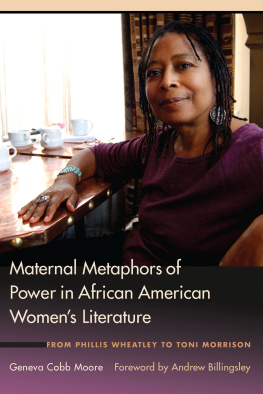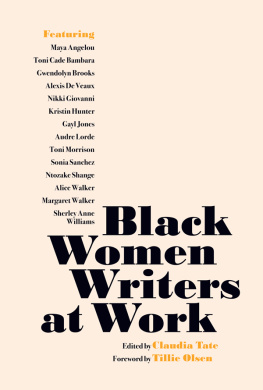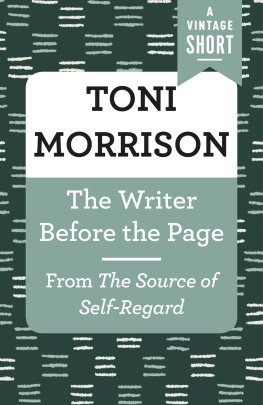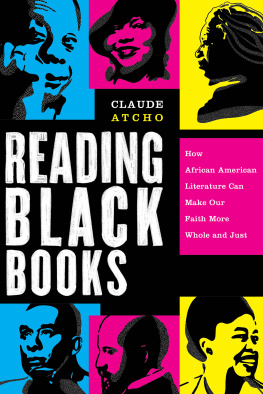
Maternal Metaphors of Power in African American Womens Literature
Maternal Metaphors of Power in African American Womens Literature
From Phillis Wheatley to Toni Morrison

Geneva Cobb Moore
Foreword by Andrew Billingsley

The University of South Carolina Press
2017 University of South Carolina
Published by the University of South Carolina Press Columbia, South Carolina 29208
www.sc.edu/uscpress
26 25 24 23 22 21 20 19 18 17 10 9 8 7 6 5 4 3 2 1
Library of Congress Cataloging-in-Publication Data can be found at http://catalog.loc.gov/.
ISBN 978-1-61117-748-0 (cloth)
ISBN 978-1-61117-749-7 (ebook)
Front cover photograph: Alice Walker, Lisa Carpenter/Writer Pictures
In Memoriam
W. C. Cobb Sr.
19121992
and
Canary Beatrice Cobb
19132000
The concept of race is nothing but a whited sepulchre, a conception which in the light of modern experimental genetics is utterly erroneous and meaningless, and should therefore be dropped from the vocabulary of the anthropologist, for it has done an infinite amount of harm and no good at all.
Ashley Montagu, ed., The Concept of Race
The ubiquity of the term race in modern discourse indicates that early-twenty-first-century Americans adhere to this creation myth with remarkable tenacityin other words, that they believe that race is real and that race matters. In fact, however, like its worldwide counterparts, the American creation myth is the product of collective imagination, not historical fact. The myth of race is, at its heart, about power relations. Who benefited from these narratives of racial difference?
Jacqueline Jones, A Dreadful Deceit: The Myth of Race from the Colonial Era to Obamas America
The idea of America as a Herrenvolk republic did not spring Medusa-like out of the minds of white folk. It emerged only after the progress and demands of free blacks [who] compelled whites to clarify and make explicit their understanding of American republicanism as the white races exclusive gift.
Paul Goodman, Of One Blood
Contents
Andrew Billingsley
Foreword
Great writers at their best often reveal significant dimensions of the histories and societies, cultures, and especially personalities of the people about whom they write. Consider, for example, the writings of Alexandre Dumas of France, Aleksandr Pushkin of Russian, Huan Soyin of China, Nadine Gordimer of South Africa, Chinua Achebe of Nigeria, Charlotte Bront of Great Britain, and William Faulkner and Richard Wright of the southern United States of America. Left to the empirical investigation of historians and social scientists alone, the development of our knowledge of history, culture, and society would be far less imaginative and complete.
It is not that literary writers can replace historians and social scientists in depicting the interactions between people and their cultures and societies. But writers, often unlimited and unshackled by objective realities, can plunge beneath the social conditions of history to reveal what is true and shocking but also what might have been or what might still be in regard to human possibility. The relation between art and society can be illustrated by the artist or writer standing before his or her society, holding a mirror and making perceptibly visible to future generations what might otherwise be considered the foreign and complicated occurrences of history that influence human conduct or stifle human aspiration.
This work places the literary writings of influential and intellectual black women in their historical times, uniquely combining history and literature or presenting literature as history. As such, the study richly adds to our understanding of the black experience from the era of colonialism and slavery in Boston with the experience of the poet Phillis Wheatley to the horrors of plantation slavery in Harriet Jacobss North Carolina and then the promise of abolitionism and the Civil War as witnessed in the diaries of Charlotte Forten Grimkand this in just the first three chapters in this study. This book continues with the Jim Crow era of the Harlem Renaissance writers Jessie Fauset, Nella Larsen, and Zora Neale Hurston; progresses to the Caribbean experience as described in the novels of Paule Marshall; and then moves on to the civil rights movement and two novelists coming out of that experience, Alice Walker and Toni Morrison. The ambition of this examination opens up a Pandoras box of American history and the tragedy and transformation of African Americans. Enslaved and freed and perpetually existing in a state of rediscovering the meaning of freedom, its restrictions, and its possibilities, African Americans offer a different narrative on history from the one constructed by the mainstream media and the general society, as this book illuminates.
I was privileged to read the manuscript of this work when I was living and working in West Africa as a Senior Fulbright Scholar and Lecturer at the University of Ghana. It was there that I first met the author Geneva Cobb Moore, also a Fulbright Scholar, teaching American literature at the university. I must confess that I initially read Professor Moores manuscript as a social scientist and was immediately struck in each chapter by the crisis of the black family in slavery and freedom, especially as depicted in the literature that she has chosen to examine. Images of African American families have not fared well, generally speaking, in American scholarship. Scholars have been perhaps overly influenced by the downside of the black experience and have little understood, until quite recently, the creative pattern of adaptation that black families have had to adopt because of their unique historical situation. Black and white American scholars have been unduly influenced by their immersion in Eurocentric cultural perspectives, which largely dominate much of American education and the public discourse on the nuclear and middle-class family.
We are all, therefore, appreciative of Professor Moores great effort and of her perceptive analyses of the works of leading African American women writers who, among other achievements, reveal the dynamic complexity of African American family structures over a wide span of time. It is possible in this study to trace the early identity of the black family from being ruptured and dispossessed to endeavoring to be made whole, intact, and self-sustaining. Among the writers treated here, Phillis Wheatley was kidnapped from her family in Africa, and Harriet Jacobs labored to maintain a basic but essential maternal relationship with the two children born to her out of wedlock after she had already lost her mother, father, grandmother, aunt, and uncles through their deaths or her fugitive-slave status in New York and Boston.
There is, however, one writer in this book, Charlotte Forten, with whom I am quite familiar because of my own research on the life of Robert Smalls, the black South Carolinian and Civil War maritime hero whom she met in Beaufort, South Carolina, on the eve of the Civil War. A writer-diarist, Forten provides an extraordinary glimpse into the world of the rare, black patrician family in antebellum America. Through Professor Moores analysis of the Journals of Charlotte Forten Grimk
Next page









